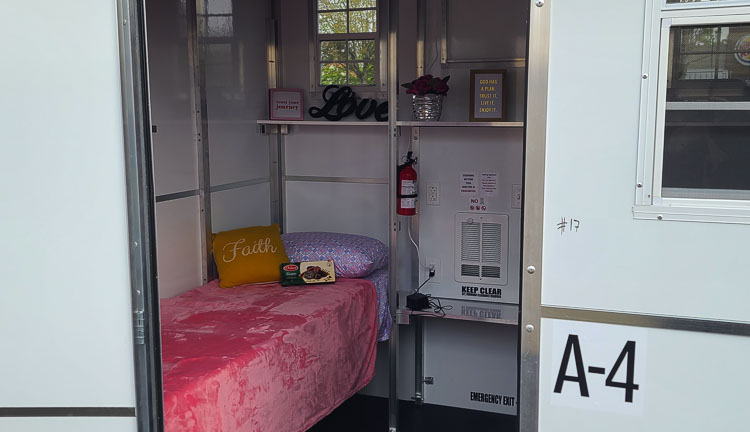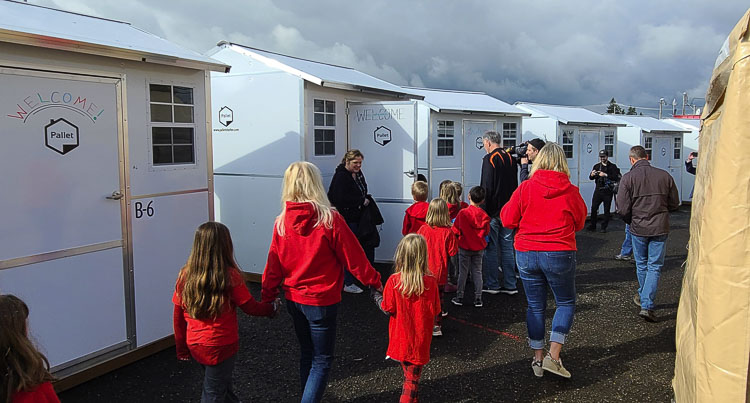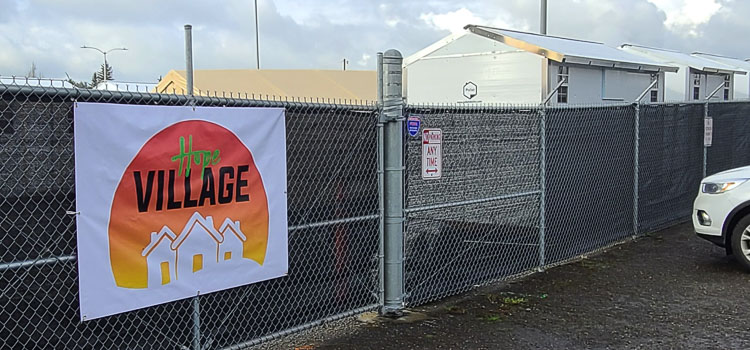Tiny homes will provide shelter and security for those experiencing homelessness
Eddy Gresko is 28 years old but has been homeless for 12 years now.
This week, the plan is for him to move into a tiny home at Hope Village.
“Four walls. Heat. And a roof. It’s better than being out here,” Gresko said. “It’s a start.”
Vancouver’s second Safe Stay Community is set to open this week, and the expectation is for it to be as successful as the first one.

Safe Stay is a supportive site for people experiencing homelessness. The new site will provide safe, stable shelter — tiny homes — for up to 40 residents who are working to transition out of homelessness.
On Wednesday, the city held a media event at the new site, located at 4915 E. Fourth Plain Blvd., on city property. The new Safe Stay community will be managed by Living Hope Church.
“This is our vision, always, to do what we can to do something to better our community,” said Brian Norris, associate pastor at Living Hope. Norris oversees the church’s homeless outreach and recovery outreach efforts.
“We have a heart for those who are hurting, downtrodden, and beat up,” Norris said. “We want to be the lighthouse where people can find hope.”

The first Safe Stay site opened in December at 11400 NE 51st Circle in east Vancouver.
According to data provided by the city, 30 people have been served at the first site. Of them, four have found permanent housing, while more are working with a case manager to find housing. More than a dozen have acquired official identification cards, and all now have health insurance. There have been zero calls for emergency services from the community since it opened.
That is a far cry from when the location was an unorganized gathering spot full of tents and tarps and fire pits.
“It was a massive camp,” said Jamie Spinelli, the homeless response coordinator for Vancouver.
Having a small home, with lockable doors, can mean so much. Less stress can lead to less chaos.
“It’s a combination of having these particular little structures,” Spinelli said.
The small structures provide heat, power to charge a phone, and light. The tiny homes at the second site will also have WiFi.
“They’re not having to focus on their most basic needs,” Spinelli said. “That takes the load off of them.”

Plus, there is support on site, 24 hours a day, from certified peer support counselors. The first site is managed by Outsiders Inn.
“All the folks we hire, including myself, … we are folks who have lived experience with any or all of the different things that revolve around homelessness,” said Adam Kravitz, director of Outsiders Inn, an organization that attempts to lift people out of homelessness through advocacy, support, and resources.
“The idea that all of us are a common survivor of the same trauma … gives us an edge to put people at ease. We understand where they’ve been. We can tell them about our journey.”
Outsiders Inn is working closely with officials from Living Hope Church.
“We’re behind them the whole way,” Kravitz said.
Norris and others associated with Living Hope Church used to bring food to the camp that is now being used as a Safe Stay’s first site.
“We’ve seen it from what it was and to what it is now, and it’s a huge blessing,” Norris said.
Living Hope has hired experts to be on hand at the second site 24 hours a day, much like the counselors at the first site.

Charles Stuart has experienced homelessness for much of the past 20 years. He acknowledged his drug addiction as the main reason. Sober for more than two years now, he will be living in one of the tiny homes but also will be an on-site manager, to help others in their transitions.
“It’s a step-up, for sure,” he said, looking at the tiny homes. “It’s pretty cool.”
The tiny homes have room for a bed and maybe a small dresser, or two beds for a couple. There are also storage sheds on site for anything that must be secured but does not fit in a tiny home. The second site has 20 tiny homes.
Ready to open this week, the second site has restrooms, running water, and garbage containers. The tiny homes have power, heat, and lockable doors. The tiny homes also have a spot for air conditioners when the weather turns. Coming soon to the second site: shower and laundry service.
The success of the first site, and the expectation for the second site, has city officials thinking of even more expansion. Spinelli said that the goal is to open a third Safe Stay Community by the end of the summer, at a location to be determined.
Part of managing such a site is also being an ambassador to the neighborhood where these sites are located.
Spinelli acknowledged that there are some people who just do not want these sites or any other homeless programs to be in their neighborhoods. But in her experience, she said most people do want to help, want to be part of the solution. It’s all about managing a solution.
“They say, ‘We are willing to do our part. We can wrap our arms around 35 to 40 people, but we cannot wrap our arms around 150,’” Spinelli said. “That’s too much.”
Serving hundreds of people at a time can be a tough task for the city, as well.
A small camp of tiny homes is an answer.
“It’s much easier to provide for 25 to 40 people,” Spinelli said.

There will always be critics, but Spinelli and others say Safe Stay is a step toward a solution to the homlessness problem.
“The people who were living outside are already living on public land. We hear those complaints all the time. They’re down at Burnt Bridge Creek. They’re out on sidewalks,” Spinelli said. “This gives a safer, healthier, more managed, structured space for people to actually transition. It’s very difficult to transition from the tents at Burnt Bridge Creek.”
She added that nearby business owners and neighbors have been happy with the management of the first site.
Once in a Safe Stay Community, residents have to be working toward a goal. That could be finding a permanent home, finding employment, or treatment for addiction. Those who leave Safe Stay to go into treatment are assured that they will have a place at Safe Stay once they return from treatment, Spinelli said.
That philosophy is working at the first site.
“Numerous people have made really brave choices about their mental health and their addictions, or any other challenges they might have,” Kravitz said.
Even the smallest space of shelter, with power, can lead to bigger and better things. Managers see it when a resident of a Safe Stay Community leaves for permanent housing.
“I’m not a super emotional person, but the thing that gets me is watching someone else become proud of themselves for accomplishing something,” Spinelli said. “Watching someone show you their new house key … there’s nothing that compares to that.”




